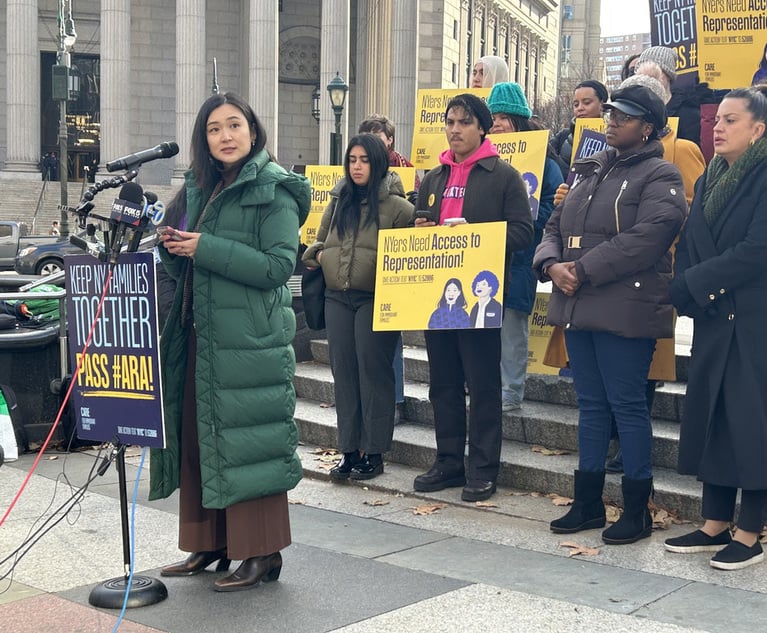 Photo: Akos Stiller/Bloomberg
Photo: Akos Stiller/BloombergGeneration Gig: Can New York State Learn From California's Legislation?
As the number of gig workers continues to grow, so do the voices calling for these workers to be treated as employees.
November 01, 2019 at 02:20 PM
6 minute read
There is no question the gig economy has changed the way people work. However, it is not often clear whether a worker is an independent contractor or an actual employee. The difference is quite significant. An independent contractor will generally not be entitled to the myriad city, state, and federal labor and employment protections that apply to employees, and will not be eligible for employee benefits, such as health insurance or pensions.
As the number of gig workers continues to grow, so do the voices calling for these workers to be treated as employees. If New York state follows in California's footsteps by shaking up the state's gig economy and allowing challenges to employers' worker classifications, millions of contract, or gig workers, could potentially become eligible for benefits similar to that of employees.
What a new-world gig landscape in New York might look like remains to be seen. As California employers react—and in some cases, such as Uber and Lyft, resist—to challenges of worker classifications, New York lawmakers should carefully contemplate the state's own possible employment law changes. New York could follow California's lead, or it could chart its own groundbreaking path.
Signed into law in September 2019, California, Assembly Bill 5 (AB5) changes the litmus test for determining whether a worker is an employee or an independent contractor. According to the AB5 legislation, a worker is considered an employee unless the hiring entity demonstrates that all of the following conditions are satisfied:
- The person is free from the control and direction of the hiring entity in connection with the performance of the work, both under the contract for the performance of the work and in fact.
- The person performs work that is outside the usual course of the hiring entity's business.
- The person is customarily engaged in an independently established trade, occupation, or business of the same nature as that involved in the work performed.
Misclassification of Workers
As New York lawmakers mull similar employment law changes, and as the number of gig workers continues to grow, many gray areas exist between the definitions of "employee" and "independent contractor," even based on California's test. Indeed, misclassification of independent contractors is an ongoing and pervasive problem that will only increase with the rise of the gig worker. Many gig workers likely fall under the independent contractor definitions already developed in discrimination law, wage and hour law, workers' compensation law and the Internal Revenue Code. Each legal framework has a different working definition, and all of them look at similar, but different factors, to determine if an employee is an independent contractor. Adding another definition tailored to gig workers may further confuse the issue. It is not clear that the definition put forth in California, if applied in New York, would actually clarify the issue, or perhaps just further muddle it. Both employers and employees would be better served by having a clear, workable and consistent definition.
|Unclear Gig Worker Counts
Besides the legal confusion, it is also unclear how many gig workers there actually are in New York, largely due to misclassification of workers, uncounted workers and lack of a clear consensus on the definition of gig workers.
A 2017 U.S. Department of Labor report indicated that there were 10.6 million independent contractors in the United States. Meanwhile, a recent MetLife study indicated that "the independent workforce" currently totals 45 million people. The gulf between the two numbers illustrates the problem of quantifying the extent of the issue.
According to the MetLife study, "[t]oday, almost 30 million Americans get their primary income from gig work, constituting nearly a fifth of the total workforce. An additional 15 million workers supplement 'traditional' full-time work with 'gigging/freelancing.'" The MetLife study also indicated that 85% of the independent workforce are interested in continuing to pursue gig work—a sign that the gig economy and its workers will be a force to be reckoned with.
Without an accurate accounting of gig workers, state legislators could have their work cut out in crafting realistic employment legislation that is amenable to employers and workers alike. "Those insights could have a tremendous impact on policymaking, infrastructure, and private-sector innovation," said Stephane Kasriel, chief executive of Upwork, in a recent article. "The more we know about Americans' new ways of working, the better we can write policies and develop products and services to support them."
|Generation Gig
The gig economy is largely defined by work based on fixed-term contracts or that is paid per project by a company, third party or online marketplace. "The term was coined in the wake of the 2008 recession, where more and more workers relied on short-term employment after losing their jobs," according to MetLife's study. "Since then, companies that leverage technologies, such as cloud, mobile broadband, GPS, or social platforms, have played an important role in reshaping the way we work. It's now more seamless than ever for gig workers to connect to employers and customers."
As New York legislators debate legislation in response to the gig economy, it is important to remember there is a category of workers that actually like the freedom and variety of gig work, and maybe some of these gig workers are gig workers because they truly don't want to be employees. State legislators should be mindful of the current state of the law on independent contractors and be careful that any proposed legislation clarifies the standards, rather than confuses them.
Partner Michael W. Macomber focuses his practice on federal and private sector employment law claims, including the Fair Labor Standards Act and New York labor law, among others, in Tully Rinckey PLLC's Albany office. Senior Associate Nicholas A. Devyatkin is a labor and employment attorney in the firm's Manhattan office.
This content has been archived. It is available through our partners, LexisNexis® and Bloomberg Law.
To view this content, please continue to their sites.
Not a Lexis Subscriber?
Subscribe Now
Not a Bloomberg Law Subscriber?
Subscribe Now
NOT FOR REPRINT
© 2024 ALM Global, LLC, All Rights Reserved. Request academic re-use from www.copyright.com. All other uses, submit a request to [email protected]. For more information visit Asset & Logo Licensing.
You Might Like
View All
Hochul Vetoes 'Grieving Families' Bill, Faulting a Lack of Changes to Suit Her Concerns

Court System Names New Administrative Judges for New York City Courts in Leadership Shakeup
3 minute read

Retired Judge Susan Cacace Elected Westchester DA in Win for Democrats
Trending Stories
- 1NYC’s Oldest Deli Agrees to Update Bathrooms, Entrances to End ADA Charges
- 2LSAT Administrator Sues to Block AI Tutor From Using ‘Famous, Distinctive’ Test Prep Materials
- 3'Immediately Stop Using' Pizza Puffs Term: Parties at Odds Over Judge's Injunctive Order Over Trademark
- 4Advertising Tech Likely to Draw More Scrutiny in 2025 Over Consumers' Data, Lawyers Say
- 5Freshfields' Former Senior Partner, Who Oversaw U.S. Expansion, Knighted in New Year’s Honours
Who Got The Work
Michael G. Bongiorno, Andrew Scott Dulberg and Elizabeth E. Driscoll from Wilmer Cutler Pickering Hale and Dorr have stepped in to represent Symbotic Inc., an A.I.-enabled technology platform that focuses on increasing supply chain efficiency, and other defendants in a pending shareholder derivative lawsuit. The case, filed Oct. 2 in Massachusetts District Court by the Brown Law Firm on behalf of Stephen Austen, accuses certain officers and directors of misleading investors in regard to Symbotic's potential for margin growth by failing to disclose that the company was not equipped to timely deploy its systems or manage expenses through project delays. The case, assigned to U.S. District Judge Nathaniel M. Gorton, is 1:24-cv-12522, Austen v. Cohen et al.
Who Got The Work
Edmund Polubinski and Marie Killmond of Davis Polk & Wardwell have entered appearances for data platform software development company MongoDB and other defendants in a pending shareholder derivative lawsuit. The action, filed Oct. 7 in New York Southern District Court by the Brown Law Firm, accuses the company's directors and/or officers of falsely expressing confidence in the company’s restructuring of its sales incentive plan and downplaying the severity of decreases in its upfront commitments. The case is 1:24-cv-07594, Roy v. Ittycheria et al.
Who Got The Work
Amy O. Bruchs and Kurt F. Ellison of Michael Best & Friedrich have entered appearances for Epic Systems Corp. in a pending employment discrimination lawsuit. The suit was filed Sept. 7 in Wisconsin Western District Court by Levine Eisberner LLC and Siri & Glimstad on behalf of a project manager who claims that he was wrongfully terminated after applying for a religious exemption to the defendant's COVID-19 vaccine mandate. The case, assigned to U.S. Magistrate Judge Anita Marie Boor, is 3:24-cv-00630, Secker, Nathan v. Epic Systems Corporation.
Who Got The Work
David X. Sullivan, Thomas J. Finn and Gregory A. Hall from McCarter & English have entered appearances for Sunrun Installation Services in a pending civil rights lawsuit. The complaint was filed Sept. 4 in Connecticut District Court by attorney Robert M. Berke on behalf of former employee George Edward Steins, who was arrested and charged with employing an unregistered home improvement salesperson. The complaint alleges that had Sunrun informed the Connecticut Department of Consumer Protection that the plaintiff's employment had ended in 2017 and that he no longer held Sunrun's home improvement contractor license, he would not have been hit with charges, which were dismissed in May 2024. The case, assigned to U.S. District Judge Jeffrey A. Meyer, is 3:24-cv-01423, Steins v. Sunrun, Inc. et al.
Who Got The Work
Greenberg Traurig shareholder Joshua L. Raskin has entered an appearance for boohoo.com UK Ltd. in a pending patent infringement lawsuit. The suit, filed Sept. 3 in Texas Eastern District Court by Rozier Hardt McDonough on behalf of Alto Dynamics, asserts five patents related to an online shopping platform. The case, assigned to U.S. District Judge Rodney Gilstrap, is 2:24-cv-00719, Alto Dynamics, LLC v. boohoo.com UK Limited.
Featured Firms
Law Offices of Gary Martin Hays & Associates, P.C.
(470) 294-1674
Law Offices of Mark E. Salomone
(857) 444-6468
Smith & Hassler
(713) 739-1250






